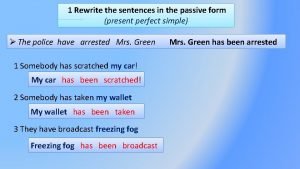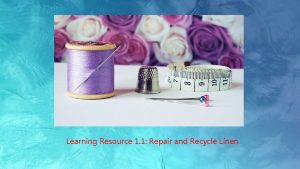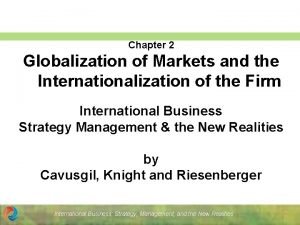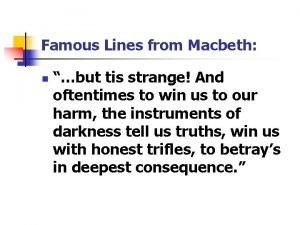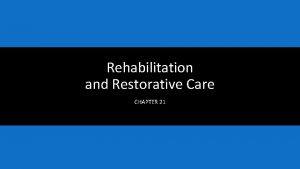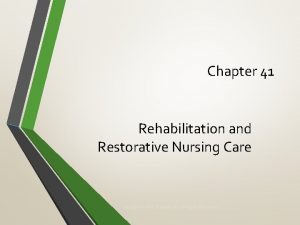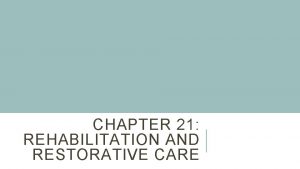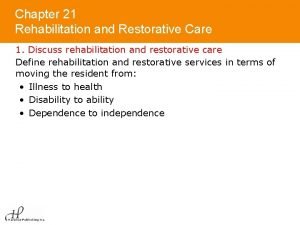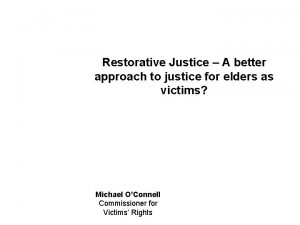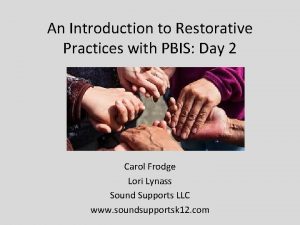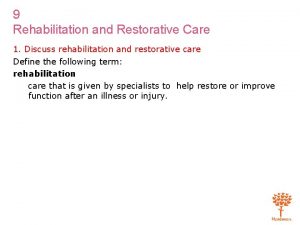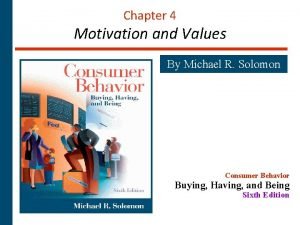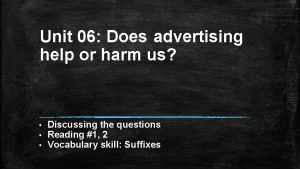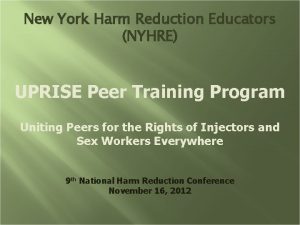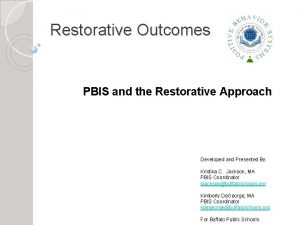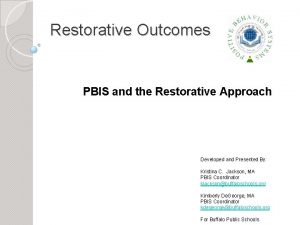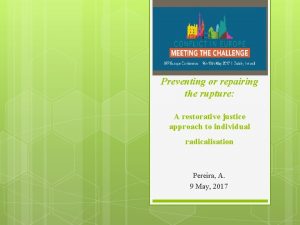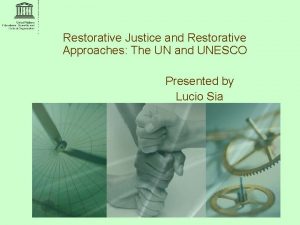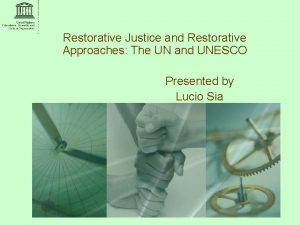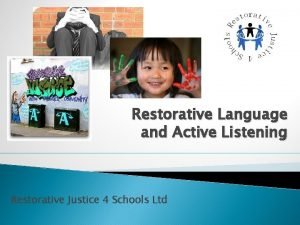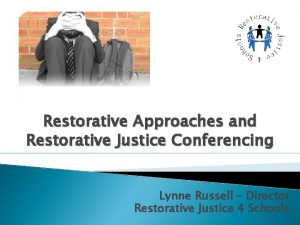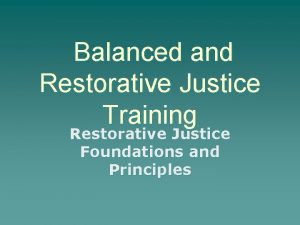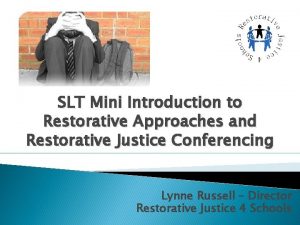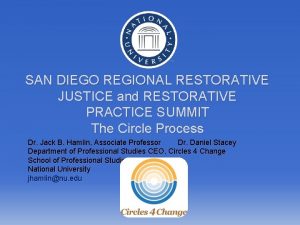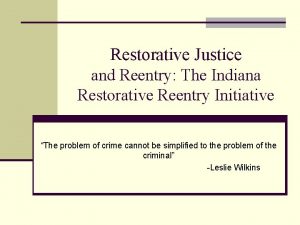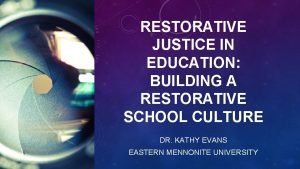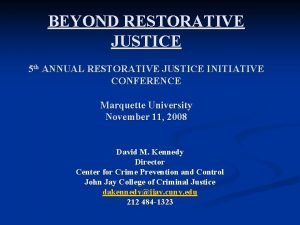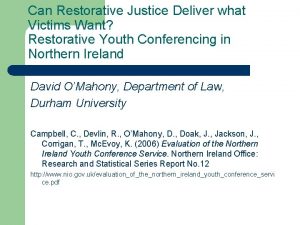A Restorative Approach to Conflict Repairing Harm and





















- Slides: 21

A Restorative Approach to Conflict: Repairing Harm and Preventing Future Harm Spokane Public Schools Office of Family and Community Engagement Repair Harm Restore Relationships Build Community

Philosophy of Restorative Practices Why SPS uses Restorative Practices as its primary approach to conflict and behavior How RP fits within the MTSS framework and discipline policies The Repairing Harm Process Learning Objectives

What is Restorative Justice? Restorative Justice brings people together to reconcile and build relationships when harm has been done. A major tenant of Restorative Justice is that harm affects everyone in the community- the “victim/s”, “whoever does the harm” and the larger community. Therefore decisions about how to repair the harm must be determined by the people affected, as they are the only people who truly know how to make things right. Restorative Justice aims to build understanding, explore how the wrongdoing has impacted those involved, and to develop agreements that increase trust, safety and understanding so that things are better in the future.

Indigenous Roots • Reflects ancient beliefs and practices of Indigenous peoples on many continents. • Building community based on shared values and shared humanity. • People in the community treat each other like relatives, where everyone belongs, and everyone matters.

Two Different Views of Misbehaviors -a paradigm shift. Punitive View What rule was broken? Who did it? System assigns consequence or punishment Restorative View What relationships were broken? Who was harmed? Why did this happen? Whose needs were not met? The impacted parties control how harm is repaired and needs are met

Restorative Discipline Shifts Telling Listening Knowing the Answers Being Curious Institution / Third Party Trying to Restore Balance Those affected trying to restore balance Focus on Wrongdoer Focus on those harmed and those who caused harm External Coercion Internal Motivation

Conflicts are a part of daily life and making mistakes is a part of growing and learning. With this in mind, SPS embraces a restorative approach to conflict, meaning that we see conflicts and harmful behavior as an opportunity for students and staff to: • Learn about themselves and each other • Take accountability • Develop empathy • Repair harm and restore relationships • Identify supports that meet the individual for each of our students. Excerpt from SPS webpage on Restorative Practices

MTSS Framework Tier 3 – Repairing Harm Formal Conferences Tier 2 – Responding to Conflict Mediation * Rupture Repair Dialogues Tier 1 – Building Community/Preventing Conflict Affective Statements * Restorative Questions * Proactive Circles

Restorative Practice Assumptions 1. The world is profoundly interconnected 2. All human beings have a deep desire to be in good relationship 3. All human beings have inherent dignity 4. All human beings have gifts and everyone is needed for what they bring 5. The people most affected by a conflict should drive the process for repair 6. Harmful behavior often comes from unmet needs; A response that pushes away generally increases harm and a response that pulls in closer helps reduce future harm. 7. People will make positive changes when those in authority do things with them, rather than to or for them. Derived from and build on indigenous teachings and other wisdom traditions. Excerpted from Heart of Hope and Circle Forward by Carolyn Boyes-Watson and Kay Pranis, as well as Boston Public Schools.

The child who is not embraced by the village will burn it down to feel its warmth -African Proverb

Think of a time when you were harmed…. What did you feel? What did you need to make things right? Think of a time when you caused harm…. . What did you feel? What did you need to make things right?

Harm in our Schools

Restorative Strategies will not be Effective and a Restorative Environment will not be Created unless: 1) Strong Relationships Exist and 2) Participants are Calm (thinking brain v. survival brain) If we want young people to be accountable for their actions and to repair damage to relationships in the event of a conflict, then we need to develop relationships in the first place. There needs to be something there to repair. Belinda Hopkins (Dir. Transforming Conflict)

Step 1: Conversation with the person who caused harm Mindset: Calm, Curious, Non-Judgmental, Willing to Listen, Open-Minded, Aware of Biases and Triggers Questions to Guide the Conversation: What happened? What were you thinking/feeling at the time? Why did this happen? Who was impacted? What needs to be done to make things right? What are you willing to do? How can you/we prevent this from happening again?

Step 2: Who was impacted? Other students You! Administrators, teachers, office staff, custodial staff Entire classes Community members or parents Their own caregivers Siblings or relatives in the school

Step 3: Conversations with people who were impacted Mindset: Calm, Curious, Listen, Open-Minded Conditions: Safe, Private, Ample Time, Trusted Adult Facilitating, Support Person Available Questions to Guide the Conversation: What happened? How did this impact you? What information do you need? What do you want the person who caused harm to know? What needs to happen to make this as right as possible? What do you need to feel safe? What questions do you have?

Step 4: Menu of Restorative Interventions Guidepost: The impacted people must determine which process guides the repair. Timing: In lieu of exclusionary discipline, during exclusionary period, or upon re-entry Types of Restorative Interventions Facilitated Restorative Conference – sharing of perspectives, impact, needs; may or may not result in agreement. Apology letters, Restitution Agreements, Community Service, Agreements to address root causes (treatment, counseling, etc) – often are the result of a formal conference.


Goals of the Repair Process For the person who caused harm: • Understand the impact of their behavior (empathy) • Take accountability for their role (self-reflection) • Repair the harm (active role in the repair) • Reintegration into the community with supports to address root causes of behavior (prevent recurrence of the behavior) For the person who was harmed: • Share their story and the impact it had on them (empowerment) • Ask questions and get answers (need for information) • Express their needs for healing and have those needs met (restitution) For the community: • Sense of safety, access to information, support role

Elements of the Repair Process Participant driven Voluntary Inclusive Primarily dialogical

Resources Spokane Public Schools Website Little Books of…… Juliesc@spokaneschools. org Coordinators – how this fits with discipline
 Electrical tools and materials
Electrical tools and materials Rewrite the sentence in passive
Rewrite the sentence in passive Repairing linen means
Repairing linen means Multiple approach avoidance conflict
Multiple approach avoidance conflict Internal and external conflict worksheets
Internal and external conflict worksheets What is conflict and conflict resolution?
What is conflict and conflict resolution? Externalconflict definition
Externalconflict definition As market globalization intensifies
As market globalization intensifies Famous lines from macbeth
Famous lines from macbeth Rehabilitation and restorative care chapter 21
Rehabilitation and restorative care chapter 21 Chapter 41 rehabilitation and restorative nursing care
Chapter 41 rehabilitation and restorative nursing care Chapter 21 rehabilitation and restorative care
Chapter 21 rehabilitation and restorative care Restorative rehabilitation definition
Restorative rehabilitation definition Pros and cons of restorative justice
Pros and cons of restorative justice Pbis and restorative practices
Pbis and restorative practices Rehabilitation and restorative care test
Rehabilitation and restorative care test A switch in a datagram network uses
A switch in a datagram network uses Deep learning approach and surface learning approach
Deep learning approach and surface learning approach Three types of motivational conflicts
Three types of motivational conflicts Advertising help or harm
Advertising help or harm Hams drinking
Hams drinking Nyhre
Nyhre

